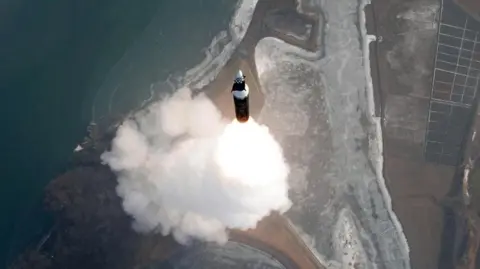North Korea says new hypersonic missile will 'contain' rivals
 Reuters
ReutersNorth Korea has claimed it fired a new intermediate-range ballistic missile tipped with a hypersonic warhead which "will reliably contain any rivals in the Pacific region".
The launch on Monday - Pyongyang's first in two months - came as US Secretary of State Antony Blinken was in Seoul for talks with some of South Korea's key leaders.
Hypersonic weapons are more difficult to track and shoot down, as they are able to travel at more than five times the speed of sound.
North Korea is claiming their missile flew 12 times the speed of sound, for about 1,500km.
South Korea's military earlier said the missile flew 1,100km before falling into the sea, adding that it "strongly condemns" this "clear act of provocation".
North Korea has previously test-fired hypersonic missiles. Pictures published by KCNA showed that Monday's missile resembled one that was launched in April last year.
But Pyongyang claims its new hypersonic missile features a new "flight and guidance control system" and a new engine made of carbon fibre.
The country's leader Kim Jong Un said Monday's launch "clearly showed the rivals what we are doing and that we are fully ready to use even any means to defend our legitimate interests", state news agency KCNA said on Tuesday.
Ankit Panda, a nuclear weapons specialist at the Carnegie Endowment for International Peace, said the launch of a new weapon is "unsurprising".
"We've known that North Korea has been working with composite materials for use in missiles for a number of years now.
"The appeal of these materials is to broadly improve the performance and reliability of the payload... Better materials can increase the odds of their survival to the target," he told the BBC.
While hypersonic weaponry has existed for decades, in recent years new missiles have been developed that are much more agile, can re-enter the atmosphere much quicker and conduct evasive manoeuvres, according to the Center for Arms Control and Non-proliferation.
Hypersonic missiles can be detected by space-based sensors. Various reports suggest there is existing technology that can intercept hypersonic missiles despite their unpredictable trajectories. These are most likely to be deployed at the final phase of their flight, where they would be flying at a lower speed after a long flight through the atmosphere.
While in Seoul on Monday, Blinken had said the US believes Russia plans to share advanced space and satellite technology with North Korea.
He added that Moscow "may be close to reversing" its decades-long commitment to denuclearising the Korean peninsula by recognising Pyongyang as a nuclear power.
During his visit, the US Secretary of State met South Korea's acting president Choi Sang-mok, where he described the alliance between Washington and Seoul as a "cornerstone of peace and stability on the Korean peninsula".
South Korea's military said it has strengthened surveillance for the North's future missile launches and is "closely sharing information" on the launch with the US and Japan.
The launch took place amid political chaos in South Korea, which has embroiled the country for weeks after suspended President Yoon Suk Yeol's short-lived martial law attempt in December.
Yoon, who was stripped of his presidential powers after lawmakers voted to impeach him, now faces arrest. The constitutional court is also deliberating whether he should be removed from office.
Pyongyang previously mocked Yoon's shock martial law declaration as an "insane act" and, with no suggestion of irony, accused Yoon of "brazenly brandishing blades and guns of fascist dictatorship at his own people".
North Korea is one of the world's most repressive totalitarian states. Its leader Kim Jong Un and his family have ruled the hermit nation for decades, developing and promoting a cult of personality.
The last time Pyongyang fired missiles was in November, a day before the US presidential election, when it launched at least seven short-range ballistic missiles off its east coast.
Earlier that week, the US had flown a long-range bomber during trilateral military drills with South Korea and Japan in a show of power, drawing condemnation from Kim's sister Kim Yo Jong.
